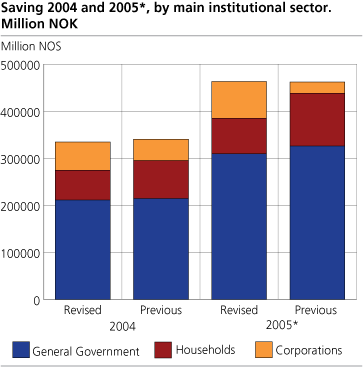Content
Published:
This is an archived release.
Fall in household saving
Compared with previously published figures, the revised figures for 2004 and 2005 show a higher national income and a higher disposable household income. Household saving and net lending are, however, revised downwards.
Revised compilations of Norwegian national accounts show national income exceeding NOK 1500 billion for 2004. As compared to preliminary figures, this is an upwards revision of 1.5 per cent. However, the 2005 figures are still preliminary.
Real disposable income for Norway has grown rapidly in later years. The growth rates were 8.0 per cent for 2004 and 9.9 per cent for 2005, an increase by 0.1 and 0.2 percentage points respectively since our previous release. These are the highest growth rates since the peak year 2000, when real disposable income for Norway increased by 16.5 per cent. The fast growth in real disposable income for these years should be considered in view of the development in crude oil prices and incomes from oil extraction.
Household saving revised downwards
Household saving for 2004 amounted to NOK 64 billions, according to the new figures. This is a considerable downwards adjustment of the former estimates. For 2005, household saving is now estimated at NOK 76 billions, a downward revision by 36 billions. The revised household saving rate is 8 per cent for 2004, down from the earlier estimate of 10 per cent. The downward adjustment for 2004 is mainly due to a higher estimate of household final consumption expenditure. The revision for 2005 is larger and more complex. For 2005, operating surplus/mixed income, as well as compensation of employees, has been decreased from earlier levels, while taxes on income and property have increased. The acquisition of capital is revised upwards, and this, along with lower saving, account for a significant downwards revision in household net lending. Household net saving is estimated at NOK 20 billions in 2004 and NOK 24 billions in 2005. The revision for 2005 amounts to 43 billion downwards.
Improved operating surplus of corporations
Non-financial corporations had a net borrowing of NOK 16 billions in 2004 and NOK 44 billions in 2005. This is, however, a strong revision as compared to earlier estimates, as net borrowing now is much smaller. The revision is due to new information on production costs related to intermediate consumption.
Still strong, but smaller growth in general government net lending
Central government had a net lending of NOK 205 billions in 2004 and NOK 292 billions estimated for 2005. Central government net lending is a measure of government surplus. Norway has had persistent surplus throughout the 2000s. Local government has a net borrowing of NOK 11 billions in 2005, but a positive net lending in 2005 of 2 billions. There are small changes to the 2004 figures, but net lending is revised downwards for 2005. The revision for 2005 is mainly due to lower tax incomes than previously estimated.
Revised balance of payments figures
For the rest of the world accounts, there is a revision of compensation of employees to non-residents. Trade in services is revised as a consequence of new shipping statistics and trade in financial services indirectly measured. The rest of the world accounts are fully harmonized with the balance of payments, which is presented in a separate article.
General information on the main revisionWe have recently published a main revision of the national accounts. Revised figures have been published back to 1970 . Figures for the institutional sectors are so far available from 2004 onwards. Revised time series for earlier years shall be published as they are available.
The revisions of the institutional accounts are mainly consequences of revisions to the central national accounts and the balance of payments. A main concern of the present revision has been to implement new methods for assessing financial services indirectly measured and their uses by sector and industry. The distribution of these financial services implies that there is an increase to household final consumption expenditure and to final consumption expenditures of government and non-profit institutions serving households. There are, however, corresponding changes to their property income, meaning there are no changes in saving of the institutional sectors. We have a new method for compiling VAT on an accrual basis d Thisiesimplies lower VAT income for the government and so lower government disposable income and saving. Government net lending is, however, not affected by the change of method.
Tables
The statistics is now published as National accounts, non-financial sector accounts.
Additional information
Contact
-
Statistics Norway's Information Centre
E-mail: informasjon@ssb.no
tel.: (+47) 21 09 46 42

